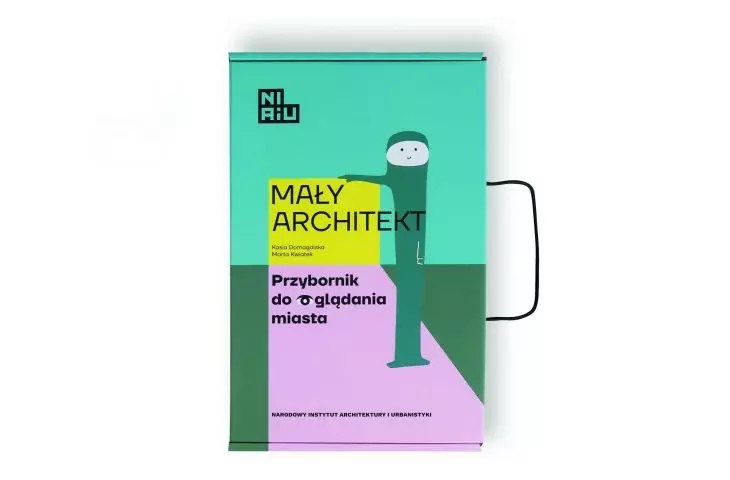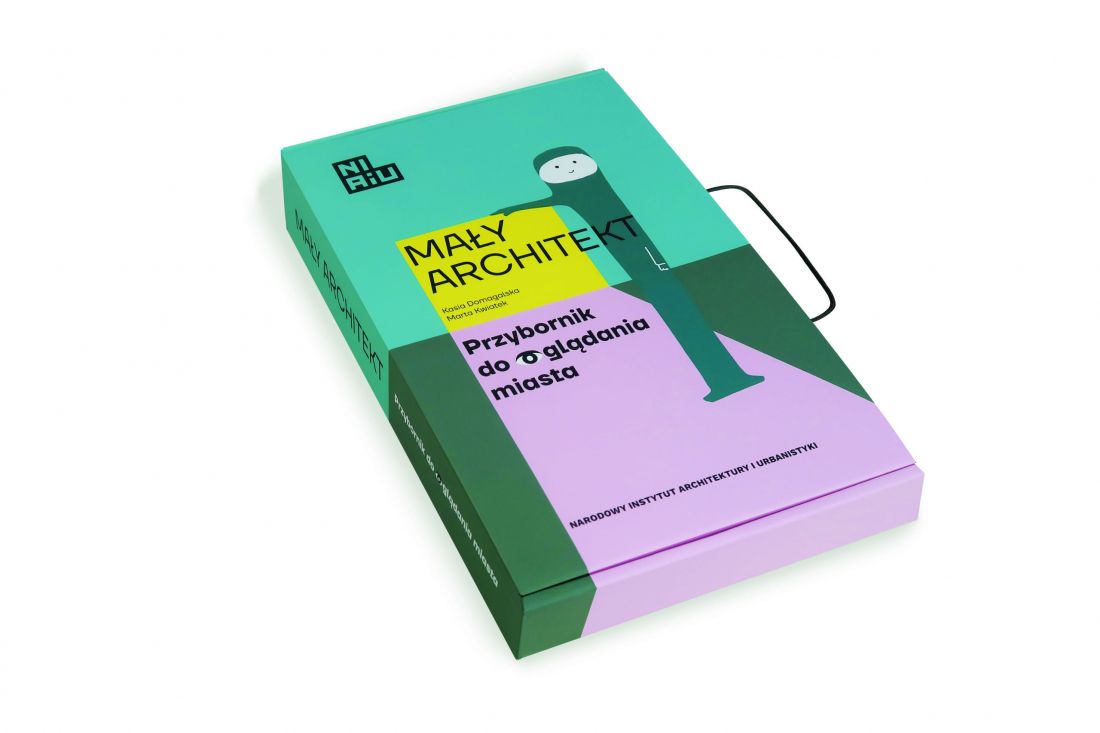Review from A&B issue 02/22.
An issue that has not yet been much discussed in relation to the increasingly raised idea of universal architectural education (PEA) is the question of tools and methodology for the transmission of this knowledge. After all, we realize that this type of education can take very different forms.
The book also contains a toolbox necessary for active use.
©NIAiU
Some are free-form, with the main purpose of arousing curiosity about the environment, while others focus on building structures, developing the ability to work as a team and achieve goals together. Still others consist of walks and talks about the city, learning about local heritage, and still others involve learning architectural drawing. A separate category are those that present certain issues and then draw participants into solving spatial not at all easy problems, and then trying to develop concepts, proposals, visions, forecasts and so on. Examples could be multiplied. Is any of these incarnations of PEA worse than another? It is difficult to compare them, to evaluate them unequivocally, because most of these initiatives are either one-off or temporary and scattered. They happen in different places - in schools, cultural institutions or private educational studios. They involve participants of different age groups and can be implemented by instructors with different backgrounds and qualifications. This versatility, openness and inclusiveness can be understood as their great asset, but also a kind of problem. This is because it is difficult to speak here of any coherent, thoughtful transmission of content, not to mention the limited possibilities of possible evaluation of the achieved effects of this process. And, after all, PEA is more about making sure that all sorts of classes, manual-construction or inspirational workshops not only develop children's, adolescents' and "adult" imagination in general, but realistically expand some basis of knowledge about architecture and urbanism among the participants. Moreover, perhaps rather, we are all already at such a stage in the history of our planet that the basics alone are not enough? On this point, imaginative and substantively valuable teaching aids could come to our rescue. Naturally, this does not mean a series of typical "learning" textbooks at all, but more "open" materials, giving the instructors a certain starting point for action and at the same time capable of "living independently" in the hands of educators, whoever they may be. Even if they were simply parents of their children who feel like delving with them into what surrounds them architecturally.
Kasia Domagała, Marta Kwiatek, "Little Architect. A toolbox for viewing the city"
©NIAiU
Such a "toolbox" was published by the National Institute of Architecture and Urbanism. Not insignificantly, it was created as the fruit of several years of cooperation between art historian Katarzyna Domagalska, who for years has been working with children and young people as part of the PEA's original initiatives, and graphic designer Marta Kwiatek, with whom they jointly managed to find an adequate form for the publication. The study was supervised by Prof. Grażyna Schneider-Skalska of the Faculty of Architecture at the Cracow University of Technology, who has been involved in the development of the PEA idea in Poland for years.
Let's be clear, this is not the first attractively published publication "about architecture" for children. There are many of them on the Polish reading market and they are excellent, clever, superbly illustrated, beautifully published. To a large extent, many of them encourage exploration of the environment, getting out of the house, looking at buildings and places both familiar and less familiar. The toolbox, however, has the unique feature, advantage and edge over many of them that it is not only meant to be with a book in the here and now, but also physically compels one to act, move, walk, go outside, test and feel with different senses. Packaged in a neat and sturdy box (which may seem like a trivial statement, but for a parent of a five-year-old it has a lot of meaning), it includes a booklet full of content, some loose illustrations of buildings, as well as a set of hardboard tools and more. There is also, among other things, a foil for drawing with a marker over pictures of buildings, a special frame for framing the most interesting views, a string, special strips of sticky tape, a piece of elastic band, a small prescription rubber, and even glasses à la Corbusier and a metal circle. The string and metal circle will serve as tools for determining the plumb line, the elastic band and cardboard ruler for measuring various things, including the proportions of the building facades. The glasses can help you feel like the French "pope of modernism" - and while times may be different now, Charles-Édouard's expressive style is invariably impressive and memorable.
an important goal of the book is to focus on action, not just reading
©NIAiU
There is quite a bit about modernism, by the way, in the accompanying booklet, but there are other contemporary references as well. However, you won't find references to obvious or, one would like to say, downright touristy examples of architecture's historical heritage. On the other hand, we will find many iconic objects, on the basis of which the authors, or rather not them, but the heroine and narrator of the booklet - Belka Słupeczańska - tells with a lot of ease: a little bit about themselves, but mostly about the relationships and processes of building, remodeling, the impact of buildings on the environment, the environment and atmospheric factors on the objects. And not only that. The content is divided into several parts. The first, "Home and Neighbors," shows this theme from the planetary level, through geographic neighborhoods, and then zooming in more and more literally to end up at the scale of a house, in addition to a very small and non-obvious one. In the next, "Orient yourself," Belka encourages us to look around us - not just to look, but to have a polysensory experience of what surrounds us, not least to realize that climate has a direct impact on how we build, in what and how we protect ourselves from its nuisances, and how and where we benefit from it. In the "I have a plan" section, we lean into the plan with Beam to find connections between the projections and masses of buildings and their functionality. Further sections are already primarily a task-divided handful of valuable, concise information and direct stimulation for action. It's hard to sit down - while you can measure, examine, discuss, touch, dress, practice architectural gymnastics (!), alter at will (and then change your mind and fade away) and finally... get inspired.
The toolbox is written in unpretentious language, which sensitively locates its message already at the ceiling of understanding the world of preschool older children, but does not avoid concepts and phrases that a caregiver or parent will be helpful in understanding. The accessible form of the booklet, however, is sure to attract older children as well, from grades 1-3 and even 4-6. The booklet is not a compendium of knowledge, but rather a loose story full of threads that, if interested, are meant to prompt readers and users to explore further. Sometimes Belka tells us about something very succinctly, and perhaps architects reading this booklet to their children would describe some concept, process or phenomenon a bit differently. But that's actually the point, to spark a conversation, an exchange of comments and insights.
the toolbox book puts the idea of "learning by doing"
©NIAiU
From the aspect of purely educational value, the formula of this book, also in terms of style, places it in a completely different system from the traditional, "teaching" oriented one, and goes rather in the direction of the idea of learning by doing and similar activating models. Its strongly resonant practical dimension is the aftermath of Katarzyna Domagalska's experience with young audiences and years of practice as a PEA educator. There is clearly an invitation to free discussion and broad interaction in her tone. The various sections of the book can be used and "reworked" in an open and authorial way, and can inspire further research activities in the space. These qualities make the toolbox one of the first teaching materials of its kind, privileged at the same time by the possibility of wide availability thanks to NIAiU. It remains to take advantage of it and to wish that in the years to come there will be ideas for other equally attractive, interestingly conceived teaching aids for general use, and not only for the youngest.






























